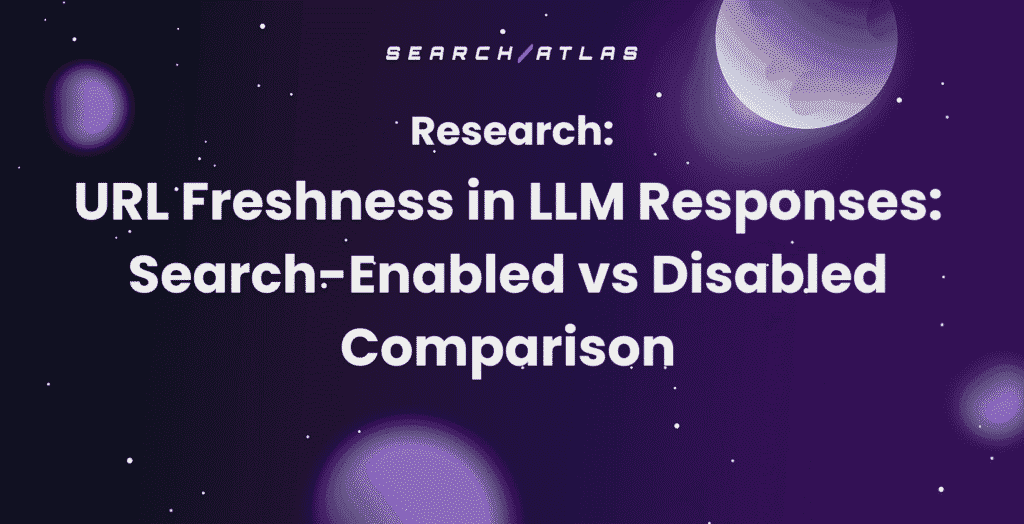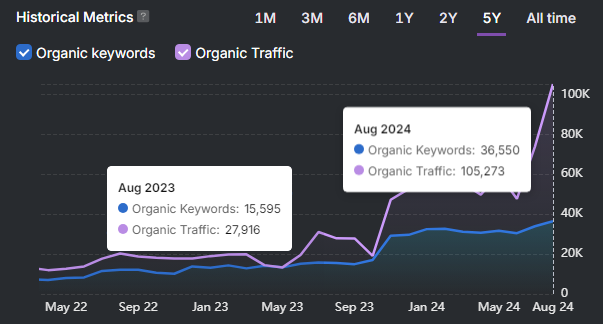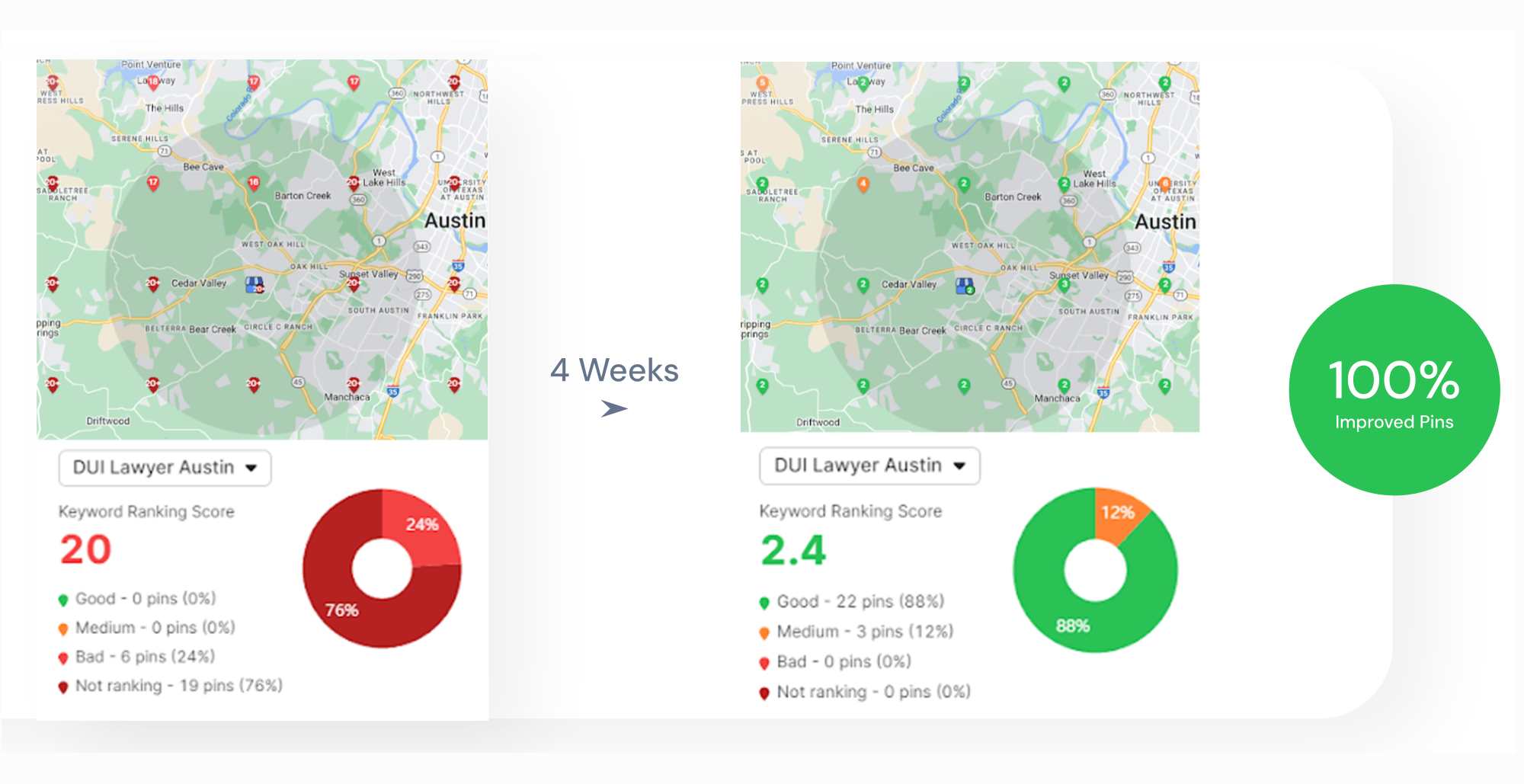Press release optimization aligns content with SEO practices like keyword targeting, link placement, and technical clarity. A well-structured release ranks for relevant queries, appears in news results, and drives qualified traffic to the brand website.
Optimized releases build long-term SEO value, boost brand visibility, earn high-authority backlinks, and expand keyword reach. Consistent optimization strengthens topical authority and increases presence across search and news platforms.
This guide covers 7 essential steps for SEO in 2025. Each step improves content structure, keyword integration, and link strategy to maximize organic performance and media pickup. Use these techniques to create releases that deliver lasting value and competitive advantage in search visibility.
What is a Press Release in SEO?
A press release in SEO serves as a digital asset that increases visibility, builds authority, and earns high-quality backlinks. It supports public relations and strengthens search engine optimization strategies. Relevant keywords, structured formatting, and credible links allow press releases to rank for target queries and gain exposure across authoritative domains. Search engines treat press releases as timely, indexable content.
Strategic distribution through trusted media networks amplifies reach and drives referral traffic. SEO-focused press releases influence brand frequency in organic results and shape how search engines assess authority. Clear structure and precise language help press releases perform across both search and media channels.

How Press Releases Help Improve SEO?
Yes, press releases help with SEO by building backlinks, increasing keyword visibility, and accelerating indexation.
Key SEO advantages are listed below.
- High-authority backlinks from media outlets and journalists.
- Faster content discovery and indexation by search engines.
- Precise keyword targeting for brand, product, or industry terms.
- Increased referral traffic from embedded links and content syndication.
Strategic optimization with targeted keywords, multimedia assets, and authoritative references drives organic search value and expands audience reach. Over 92% of journalists use online search to research stories. SEO-optimized press releases improve discoverability and strengthen trust across search and media ecosystems.
How to Optimize a Press Release for SEO in 7 Steps?
Optimizing a press release for SEO begins with a clear understanding of how search engines assess content relevance, authority, and user value. When structured and distributed effectively, a press release becomes a high-impact asset that boosts keyword rankings, earns authoritative backlinks, and amplifies online visibility.
There are 7 steps to optimize a press release for SEO. The 7 steps to optimize a press release for SEO are listed below.
1. Write a Compelling News Story
To write a press release with clarity and SEO value, first define a newsworthy angle. Weak or irrelevant stories fail to earn media coverage or rank in search. Focus on announcements that matter—product launches, partnerships, awards, or major milestones. Use language that informs rather than promotes. Study how journalists frame stories and match that tone.
Search Atlas Content Genius, which is Search Atlas content optimizer tool, streamlines this process through its AI-powered press release generator. Instead of brainstorming or conducting manual research, use Content Genius to research, build, and polish your press release.
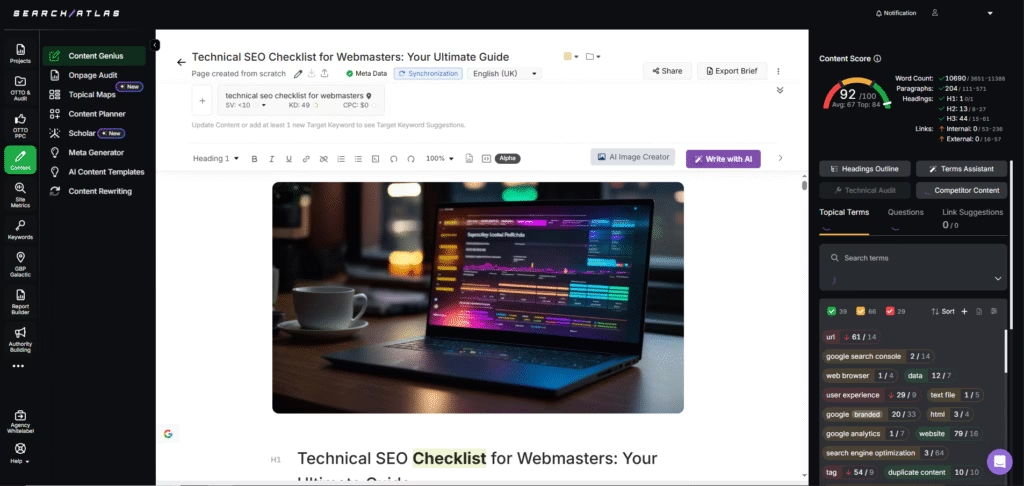
Go to the “Content” section in the main menu, open “Content Genius,” enter your topic and keywords, then click “Generate Article.” Select “Press Release” from the template options and provide the required inputs.
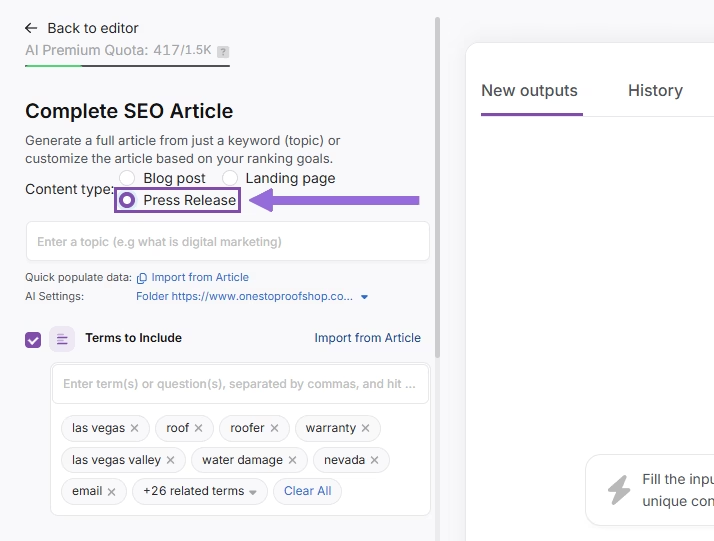
Once generated, edit the press release directly within the assistant. Each press release uses one AI Premium Quota, which resets monthly. This tool saves time and delivers ready-to-publish content structured for SEO and journalist expectations.
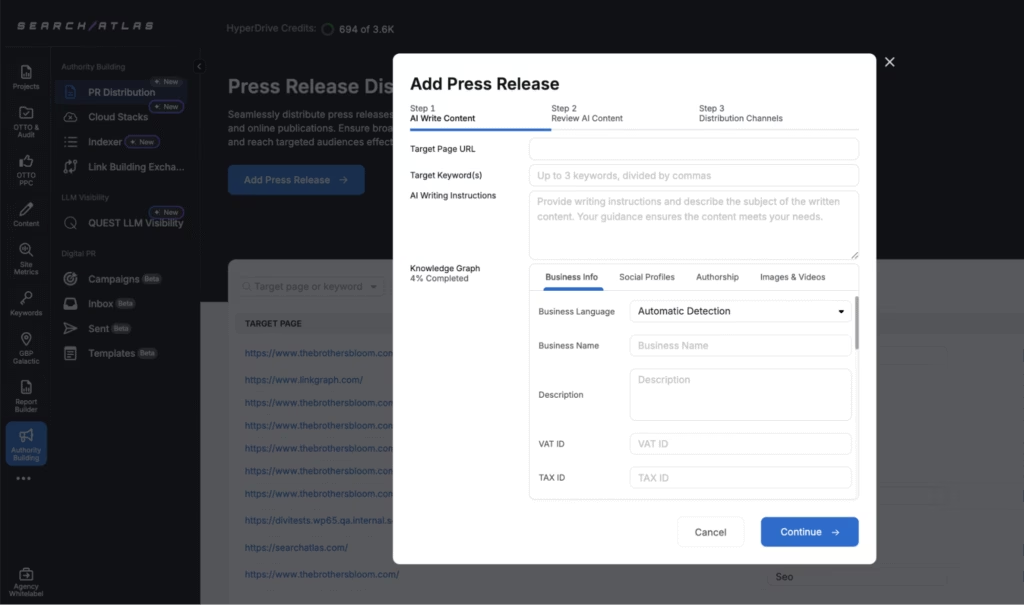
Use Search Atlas Press Release Distribution to write and publish press releases in one streamlined workflow. Enter your business info, target URL, keywords, and assets—then let the AI generate the content. Review, edit, and confirm the draft. Select media channels, apply Boost or Dynamic options, and click “Publish” to distribute across high-impact outlets. Build authority, earn backlinks, and boost SEO from one place.
2. Identify the Keywords
Press releases fail to reach journalists, customers, or decision-makers without keywords. Search engines prioritize relevance, so every press release must reflect the language people actually search.
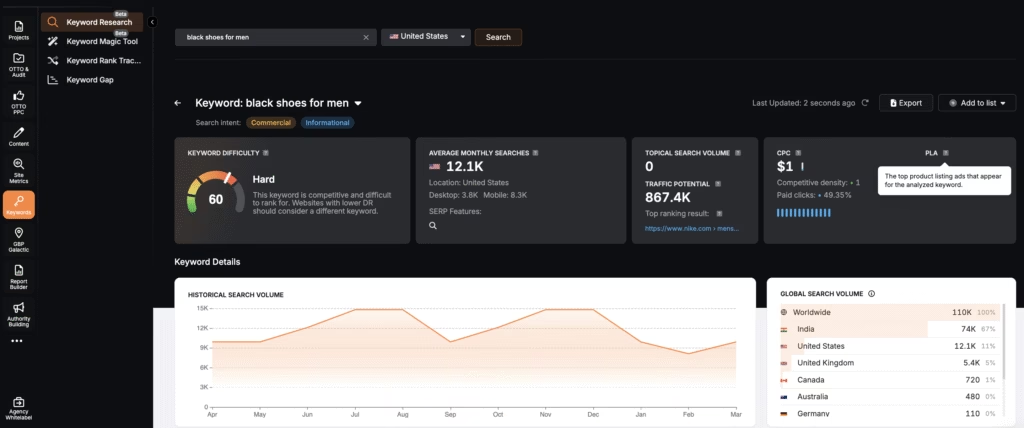
Start with the Search Atlas Keyword Research Tool to find keywords aligned with your announcement. Identify both high-volume and long-tail terms tied to your topic.
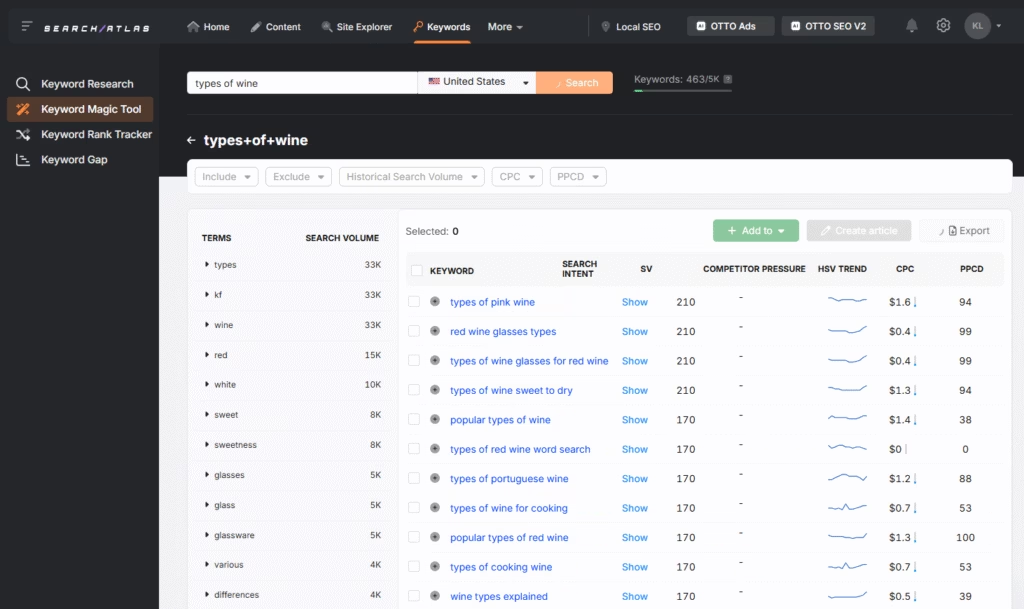
Use the Search Atlas Keyword Magic Tool to group related phrases and uncover keyword clusters. For example, a product launch press release might target “AI analytics software” alongside related terms like “enterprise AI solution” or “predictive insights tool.”
Select 3–6 core phrases. Avoid overload. Combine broad terms with specific variations. Use a layered approach—target keywords that share embedded terms. Example: “Nonprofit donation press release” hits both “nonprofit press release” and “donation press release.”
Place primary keywords in the headline, subheading, and lead paragraph. Distribute secondary terms in anchor text, bullet points, and alt tags. Write naturally. Read every sentence aloud to check for clarity and flow. Replace repetition with synonyms.
Before publishing, review for forced phrasing or keyword stuffing. A well-optimized press release ranks in search results and delivers value to readers through relevant, searchable language. Use keywords with intention and precision.
3. Craft Catchy Press Release Headlines
Your press release headline is the first and most critical opportunity to earn media attention. It must be clear, newsworthy, and designed to meet the expectations of journalists and search engines alike. A strong headline improves visibility in search results and directly influences click-through rate (CTR), driving more readers to engage with your content. Follow the Google News headline requirements listed below.
- A minimum of 10 characters
- Between 2 and 22 words
- Displays about 60 characters in results
Stay within these limits to ensure your headline appears properly across all major news platforms.
There are many best practices for crafting an effective press release headline. The best practices are listed below.
- Make a Clear, Compelling Statement. Communicate the core news and its relevance. Avoid vague words, acronyms, or internal language. Focus on what matters to journalists scanning dozens of releases. Example: Social Media Agency Launches New Division to Serve B2B Startups.
- Focus on the Core Message, Avoid Promotional Fluff. Skip sales language. Present a factual, value-driven angle that highlights newsworthiness. Example: Brand Strategy Firm Expands to Chicago After 300 Percent Revenue Growth.
- Use Numbers to Enhance Credibility and Impact. Quantify the story with specific data. Journalists favor clear, verifiable details. Example: Creative Agency Signs $500K Contract with E-Commerce Giant.
- Use Punctuation to Add Clarity. Separate ideas with colons or commas to improve structure and scanability. Example: New Report: Ad Agencies Prioritize Short-Form Video in 2025 Strategies.
- Keep it Short, Bold, and Scannable. Write concise headlines with simple structure. Focus on immediate clarity. Example: PR Agency Launches Crisis Toolkit for SaaS Startups. Launched to Support SaaS Brands Facing Reputation Challenges.
- Tailor Your Headline to Journalists. Focus on relevance to the journalist’s beat and current trends. Example: Design Agency Unveils Survey Results on Remote Creative Teams.
- Test and Refine Your Headline Before Publishing. Write several versions. Use tools like Content Genius to preview and select the top-performing headline. Original: Agency to Expand Digital Services in 2025.
- Use Meta Generator to Boost CTR. Optimize your headline with Search Atlas Meta Tag Generator to improve visibility and search performance.
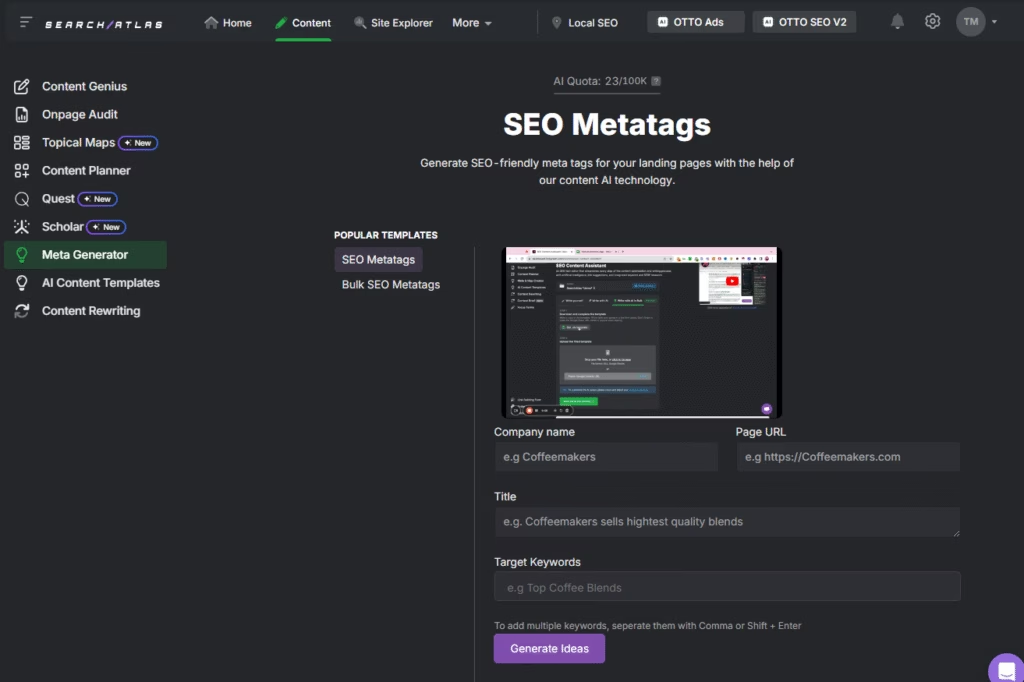
4. Structure the Press Release Correctly
Writing a press release is the most critical step in turning your announcement into media coverage.This is where you present your news in a format that is journalist-friendly and SEO-ready.
An effective press release communicates the announcement clearly, while positioning your company as a credible source of information. To maximize visibility and reader engagement, you must follow a precise format that prioritizes clarity, conciseness, and news value.
The best practices for writing a press release are listed below.
- Start with a Clear, Concise Announcement. A well written press release begins by answering the five W’s: who, what, where, when, and why it matters. This information should be placed in the lead paragraph immediately following the headline.
- Use the inverted pyramid format. Start with the most important facts, then expand with supporting details. State the announcement and its relevance in the first few lines to capture attention and establish the news value.
- Add a summary section with bullet points. Above the first paragraph, include 3–5 concise bullet points summarizing the announcement. Use this space to highlight the key data, milestones, or facts.
- Write in an active, authoritative tone. Use active voice to clearly communicate who is taking action and why it matters. This improves clarity and strengthens your messaging.
- Maintain a formal tone throughout the release. Avoid casual or overly conversational language. Remember, a press release is an official corporate statement and should read as such.
- Use the body to expand and support. After the introduction, use the body paragraphs to add context. Explain the significance of the announcement and how it affects stakeholders, customers, or the industry. Include quotes from company executives, partners, or subject-matter experts.
- Be concise and informative. Effective press releases typically range from 300 to 500 words. Every sentence should add value. Avoid filler, repetition, or overt sales language. Focus on clarity, relevance, and factual storytelling that aligns with your broader communication goals.
- Insert relevant data and context. Support your story with key statistics, proof points, or market research. Data-driven context gives press releases more credibility and helps position the story within a broader industry narrative. It also reduces the research burden for journalists, which increases your chances of coverage.
- Include a quote and a Call to Action (CTA). Clearly state the next step you want the reader to take. Whether it’s attending an event, visiting a landing page, or contacting a media rep, your CTA should be direct and easy to follow.
- Close with boilerplate and contact information. Wrap up the release with a boilerplate, a 75 to 100-word overview of your company.
5. Build High-Quality Press Release Backlinks
Backlinks boost authority and improve search visibility. A press release offers a natural opportunity to earn quality links when it delivers value, relevance, and credibility. Use the tips below to strengthen your link strategy with precision.
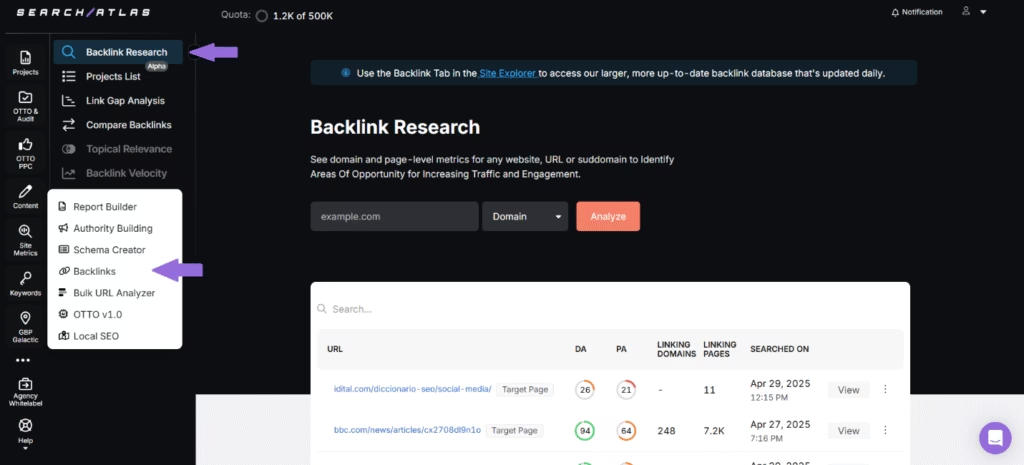
Start with the Search Atlas Backlink Research Tool to identify which domains link to similar content in your industry. Look for relevant, authoritative sites with high Domain Power. Filter by topic, publication type, and referring page quality to build a list of backlink targets.
Insert links with intention. Add one link every 100 words. Place them in the lead paragraph, inside the main body, and above the boilerplate. Link only to pages that provide added value or context to the press release. Example: Link to a new product page in a launch announcement.
Use varied anchor text. Mix branded terms, descriptive phrases, and action prompts.Examples: “Learn more about Vireo’s platform,” “Request an AI strategy demo.”
Avoid repeating the same anchor across all links. Use no-follow attributes for paid or syndicated placements. This prevents penalties while still driving traffic.
6. Craft the Press Release Boilerplate
Press release boilerplate is the closing section of a press release, but its strategic value should not be underestimated. It functions as the “about us” snapshot, giving journalists and readers essential context about the organization issuing the announcement.
There are many tips to write a boilerplate. The tips to write a boilerplate are listed below.
- Include key contact information. Add a direct name, email, phone number, and website to simplify media follow-up.
- Summarize your company profile. State who you are, what you do, where you’re based, and when you started.
- Highlight your mission and values. Share your purpose and core principles to build trust with media and audiences.
- Tailor to your industry and audience. Align language with sector norms and emphasize what matters to your readers.
- Ensure legal accuracy. Add any required disclaimers or compliance references for regulated industries.
- Keep it current and consistent. Update regularly and use the same version across all releases.
7. Distribute Press Releases Across Different Channels
Strategic press release distribution is critical to achieving long-term SEO value and brand visibility. While the content itself must be newsworthy and optimized, the true impact lies in where and how it is published.
Press releases distributed through authoritative media outlets earn high-quality backlinks, increase brand exposure, and enhance your site’s credibility in the eyes of search engines. To maximize SEO results, focus on press release syndication networks that offer long-term placement.
High-authority platforms improve your chances of media pickup while also contributing to domain authority and keyword rankings. Limit distribution to press release channels that align with your niche to attract relevant audiences and organic traffic.
Be intentional with your anchor text strategy, link placement, and media outreach to ensure every press release supports your broader SEO goals.
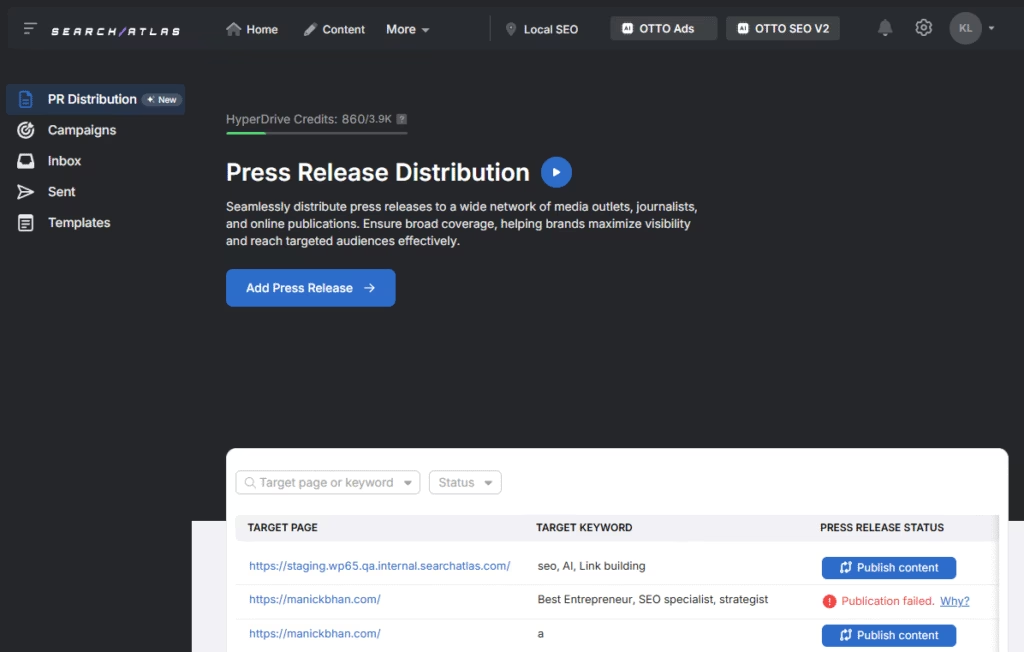
Use the Search Atlas Press Release Distribution tool to handle both writing and distribution. Users simplify headline creation using the built-in AI, which generates optimized titles that meet Google News criteria.
The Search Atlas Press Release Tool supports long-term visibility by distributing releases across a network of high-impact media outlets. The tool syndication produces sustained backlinks and referral traffic. The platform supports scalable outreach, helping brands maintain PR consistency while meeting SEO benchmarks.
Use Search Atlas OTTO SEO to automate press release distribution and syndication. It validates keyword density, structure, and readability in real time. Once finalized, OTTO SEO deploys the release across digital channels, amplifying search rankings, generating media coverage, and supporting broader content strategies.
What Makes a Bad Press Release for SEO?
A bad press release lacks news value, ignores SEO structure, and fails to meet media standards. These issues block indexing, limit sharing, and reduce pickup by trusted outlets. Weak releases focus on self-promotion instead of clear, relevant news.
Common flaws include missing metadata, weak headlines, no keyword targeting, and poor formatting. Press releases that skip subheadings, ignore geo relevance, or lack internal links lose visibility in Google News and syndication networks. Without structure, they fail in both search and distribution.
Another mistake is isolation. Press releases need to align with a broader digital PR strategy. High-performing releases support content clusters, reinforce topical authority, and link to key landing pages. Strong press releases tie into measurable KPIs like referral traffic, backlink growth, and indexation. Without these, the release adds little long-term SEO value.
Do Press Releases Need Pictures?
Yes. Include high-quality visuals to boost engagement, improve readability, and support SEO. Use images, infographics, or product shots with optimized alt text to increase media pickup and social sharing.
What Is the Ideal Word Count for a Press Release?
Keep the press release between 400 and 600 words. This range delivers a focused message, adds supporting details, and includes a clear call to action without overwhelming readers.







